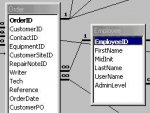I have a basic design question.
In an Order table, I have a Writer field and a Tech field.
Writer and Tech can be the same person.
The Writer field in the Order table relates to the EmployeeID in an Employee table.
Tech should relate to the same ID number but of course I cannot establish that relationship directly.
How do I construct the necessary relationship?
In an Order table, I have a Writer field and a Tech field.
Writer and Tech can be the same person.
The Writer field in the Order table relates to the EmployeeID in an Employee table.
Tech should relate to the same ID number but of course I cannot establish that relationship directly.
How do I construct the necessary relationship?

